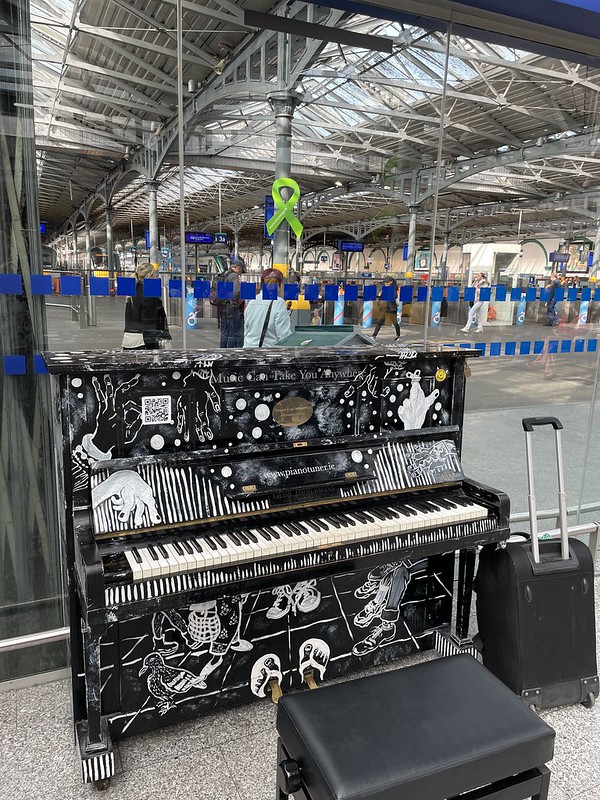To be frank, if I had a life plan, the reality did not exactly align with it. What this means is I didn’t comply with society’s expectations for me (to bankrupt myself buying property in a property boom in Ireland, effectively) and I only got around to buying my own piano when I was 49 years old. I started hiring one about 4 years before that. So for a good chunk of my life, I assumed that as soon as I bought an overpriced house in Ireland, I would wander down to Pianos Plus and buy a piano too. Something to play until I had saved up the money for a grand piano, probably a Kawai. They have nice grand pianos.
The holy all of that is that for most of my adult life, I didn’t play the piano regularly. I played pianos in piano shops. I was too scared and shy to play them in railway stations, such that the first time I did was emotionally a big thing. I chose the Gare du Nord to do it as well. For some reason, I’ve always been afraid of disturbing people. I’m not sure why. Plenty of people disturb me. Anyway, the frank end all of this is that I’m never going to be a concert pianist and people are never going to be discussing my habit of wearing trainers and a Christian Dior dress on the stage of a concert hall. I don’t know how Yuja Wang plays the pedal with high heel shoes. That aside. I do want to play as well as I can and that means pushing myself.
One of the other things I put myself through were work recitals and there, there were a lot of people who clearly played classical music better than I can. There are a couple of reasons for this but the clear one is they played more than I did. I’m not saying I want to catch up but I will say this: if I play more I will get better.
There is a lot of material about getting better at the piano on the internet. None of it is really obviously pitched at me or people like me.
Most of what I find on the internet – with some notable exceptions – assume one of two things:
- I am a complete and utter beginner
- I am a full time student with aspirations of being a full time concert pianist playing all the great concert halls.
There are different impacts for both assumptions:
Complete and utter beginner
Here’s all the stuff you need to learn how to read music. Here are easy arrangements of famous pieces of music. Here are cheat sheets so that you can get away without practising that much. Here are crappy videos so you don’t even have to learn how to read music in the first place.
Full time student who is the next Evgeny Kissin
You have all the time in the world to engage in reading crap tonnes of things, practice 12 hours a day, create practice journals, bullet journal planning, learn every study written by Chopin plus the Liszt transcendentals.
I am none of these people.
Seriously. I would suggest that the following is more likely to be true: I’m not a complete beginner. I also have a full time job that often spills over into more than full time. There are days I have worked pretty much 12 hours. I spent a good chunk of my life dealing with household management. For any adult, especially people who have kids or pets, there is not 24 hours in every day. I sometimes have to get up at 5.30 to go on business trips. I get home at 8 or 9pm. Around that, I have to eat, clean. All that.
What I am saying is that for people like me, we’re looking for a little organisational help which does not involve spending ages in personal piano administration. I do not want to spend time doing lots of planning in advance of a practice session. Right now I’m trying to correct fingering for one bar of Bach. I don’t need to write a paragraph or a bullet point on this.
I probably need a teacher but without cleaning up my work schedule it’s going to be difficult (it’s coming though, oh boy is it coming).
So, yeah, I intend to avoid the YouTube videos that tell me to spend time I haven’t got over planning one line objectives: Play this piece properly.
That aside, I want to mention that there are a couple of actual teaching accounts which focus on technique and clue you in for how to play particular pieces. So special mention to the online teachers who assume you can organise yourself but if your objective includes dealing with the polyrhythms in Debussy and Brahms, here’s some support. Kudos thus to ToneBase, Josh Wright Piano, Denis Zhdanov, LeCheile music, Pianist Magazine
That being said, Pianist Magazine ran a competition for amateurs and wrote a piece on a review of their competitors and how many of them had full time, often highpowered jobs. They focused a bit too much on the music/maths link for my liking.
I suspect the vast majority of people who buy that magazine are people who are not full time concert or otherwise pianists. In many respects, it’s the people who love pianos, the sounds pianos make and they sounds they can make with pianos who are where the money is in the piano industry.
More people like me, I guess.
















